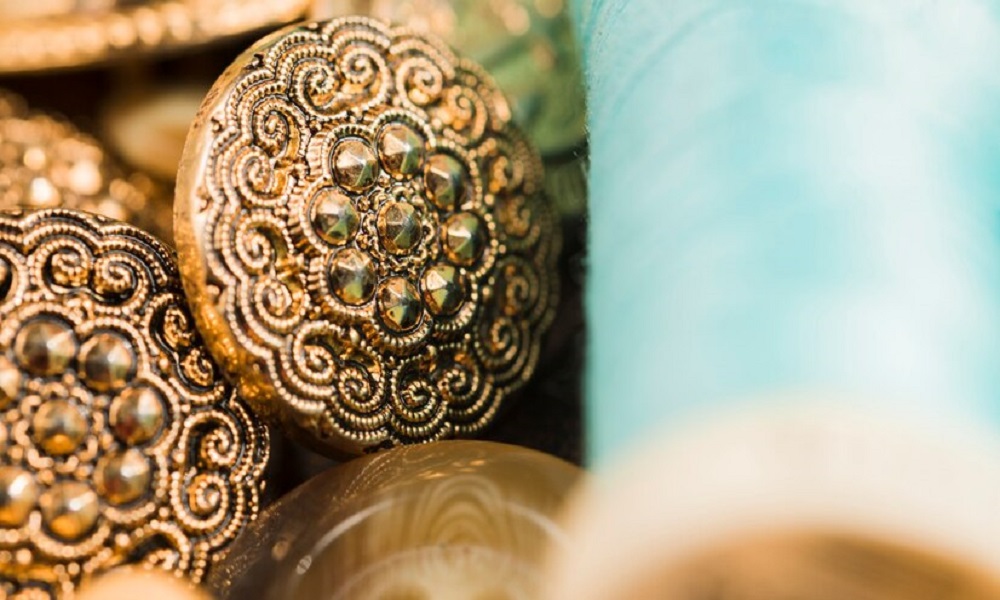The word zari conjures up a fairy tale of grace, beauty, and opulence, and has been adding glitter and glamour to our wardrobes for centuries. But do you know the story behind this rich and royal tradition? Some of you may be aware that zari is more closely linked to its Persian roots, especially the Mughal period,but the fact is that in India also gold and silver thread weaving was done well before that.
According to researchers, the sacred cloth of gold, or hiranya mentioned in the Rig Veda is very similar to present-day brocades or garments woven with zari. Some of the earliest references of this craft are from China and Egypt but the precise birthplace is uncertain.
From the time of Kushans, the rich embroidery on scarves, veils, shawls, and leather items testify to the presence of both written and sculptural sources of the bygone era. The period of prolific activity in the arts and crafts was ushered in during the period of Guptas (4th-6th centuries CE). A significant historical source is constituted by the paintings of Ajanta.
Acaranga Sutra, which was the sacred work in Jain literature, was an important literary source from the 6th century CE, that mentions gold embroidered material as something that should be shunned by monks.
The Travels of Marco Polo in the 13th century details the riches of the Tamil Pandya kingdom. He mentions carrying back cushions and mats skilfully embroidered with gold and silver wire’. Banabhatta was the biographer of King Harshavardhana of Kannauj (590-647 CE) and in his texts, Harshcharitamanas and Kadambari clearly mention the various clothes and footwear embellished with gold and precious stones. The 8th century Sanskrit classic, Kuttanimatam by Damodargupta, the minister of Jayapida Vinayaditya of Kashmir also mentions the same about the craft. As word of India’s riches spread far and wide and trade activity increased detailed references to gold- and metal-thread clothing abounds at this time.
An increase in the gold trade across the Silk Road whose expansion as a major overland trade route received a thrust with the rise of Islam was thus another major factor that led to an increase in demand for embroidery of this kind.
In Arabic literature accounts of gold-embroidered textiles are plentiful and these exquisite creations enthused the imagination of weavers and embroiderers in India. Our Indian artisans started experimenting with the art and thus led to numerous influences including the folk idiom. This further led to a variety of new ways of embellishment, and textiles from the Indian subcontinent became increasingly sought after.
With the establishment of Muslim empires in the subcontinent, Gold and silver embroidery in India attained new heights of excellence. Brocades, velvets, coats, trappings, harnesses, canopies, tent fabric, wall hangings, floor spreads, and even shoes one could find the use of Zari! In fact, the biographer in Muhammad Bin Tughlaq’s court of Delhi, Shihab Al Umari (1300-1349it mentioned that as well as it is mentioned in the accounts of Ziyauddin Barani, Ibn Batuta, and others – various Delhi Sultanate era historians.
The craft got further encouragement during the Sultanate period. It became fashionable to present robes embroidered in gold and silver to royal guests became a fashion. In Futahat-i-Firozshahi, the memoirs of Firoz Shah Tughlaq not only identified the different types of clothing and their use but perhaps also, for the first time, coined the word ‘zardozi (‘zar’ for gold and ‘dozi’ for work). The establishment of workshops or karkhanas during this period led to further institutionalization of the art form.
This precious art simultaneously flourished and reached to other parts of India as well, such as Andhra Pradesh, Bihar and Gujarat, and medieval Hindu kingdoms in and around the Deccan began to use Persian terms for the gold- and silver-embroidered cloth that they were already producing.
In the bygone era, only the high and mighty in the social hierarchy, that is the royalty and the priestly class – had the honour and privilege of wearing garments that were embellished with precious metalwork. Iron, platinum, copper, bronze, tin, and lead were some of the commonly used metals in ancient times.
Europeans, spellbound by these artistic wonders, were importing brocades and even trying to make some of their own right from the 15th century, But the important question is what is zari and how is it made? Zardozi is the most common term for this kind of embellishment and is often used more in a generic sense. However, across India each region has its own name for this kind of work: gota-patti in Rajasthan; dori/marori work and mukke-ka-kaam in Rajasthan and Gujarat, zardozi in Bhopal, Hyderabad, Delhi, and Uttar Pradesh; kamdani or badla in Lucknow; danka and tilla work in Jammu & Kashmir and parts of Western India.
The process of zari-making remains the same irrespective of any name you wish to give it. In general, it may be noted that zardozi turns an assortment of gold or silver alloy into a compressed wire known as badla, which is usually wrapped around cotton or silk thread. This composite thread is quite flexible and available in different thicknesses in mainly two colors which are sunehri (golden) and rupehri (silver). With the advent of time, some of these processes have become mechanized however the embroidery is still done entirely by hand.
Agra, Varanasi, Burhanpur, Bhopal, Lucknow, Hyderabad, Lahore, Delhi, Madras, Aurangabad, Bombay, and Surat were considered to be the most distinct and popular schools of embroidery in earlier times. Though even today one can easily see that most of these places are still renowned for metal ornamentation. Amongst the above-mentioned cities Surat led the way in mechanization and creating of cost-effective products with the use of electroplating, etc, and thus the reach of zari to the middle class. One can say that Surat has become proficient in producing inexpensive, imitation zari, which uses copper alloy instead of gold, the pure zari produced in Varanasi still remains unparalleled and unchallenged.
Natural elements such as flowers, leaves, fruits, animals, and birds have been largely used to base the designs on brocades. One can often find the keri, or mango, as a common motif used mostly on saree pallus. Apart from that one can also find geometric patterns, Persian -inspired abstracts also in common. So how is a novice able to make out the difference between imitation and pure zari? The few things to be kept in mind are the following: pure zari is much softer and smoother while imitation zari tends to give a rough/coarse feeling. Pure zari is certainly much heavier than imitation zari. Lastly, pure zari does not come cheap and indeed is a costly product. But now since the students are aware that why it is so valuable, it is worth the money paid for the royal feeling, isn’t it?
Author:
Kakoli Biswas, Associate Professor, School of Fashion Design, Unitedworld Institute of Design (UID)
Disclaimer: The opinions / views expressed in this article are solely of the author in his / her individual capacity. They do not purport to reflect the opinions and/or views of the College and/or University or its members.






